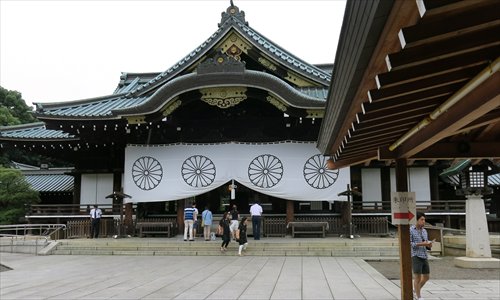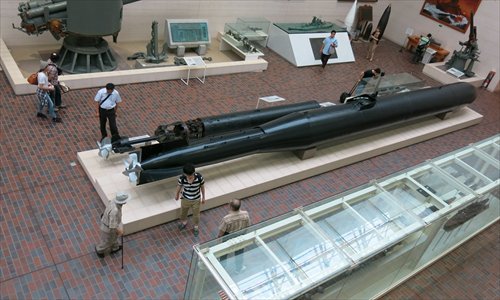War criminal worship
By Li Qian in Tokyo Source:Global Times Published: 2015-8-6 20:38:01
Japan’s Yasukuni Shrine continues to ignore the history of WWII

People visit the Yasukuni Shrine in central Tokyo. Photo: Li Qian/GT
On a rainy day outside of the Yasukuni Shrine in central Tokyo, a middle-aged man shouts through a loudspeaker that the existence of "comfort women" during WWII was a lie.
His pals reach out to passersby asking them to sign a petition urging the Japanese government to deny the existence of such women.
Their demands easily categorize this organization, called Happy Science, as falling firmly into Japan's right-wing political camp. It's not uncommon to see such rightist organizations promote their views at the Yasukuni Shrine, which itself has long represented right-wing political pursuits in a country that has long deviated from the internationally accepted historic narrative of WWII.
Among more than 80,000 shrines in Japan, only Yasukuni has repeatedly appeared at the center of international disputes about its decision to enshrine those found guilty of war crimes by the International Military Tribunal for the Far East.
In a recent e-mail interview with the Global Times, Yasukuni Shrine management went further and denied the existence of these "war criminals."
"Those enshrined all sacrificed their lives for the country and are all equal. From a domestic point of view, 'war criminal' is a concept that does not exist. This is the reason why people who your country claims to be war criminals have been enshrined in Yasukuni for the past 70 years since the war," the Yasukuni Shrine's PR Department wrote in Japanese.
It also ruled out the possibility of removing war criminals and enshring them at some other designated place - a solution proposed in Japan in recent years.
"It is not possible to change the way people are consecrated due to factors such as politics or international relations," it wrote.
Equivalent to the Nuremberg Trials in Europe, the Tokyo Trials (1946-48) brought Japanese militarism to justice. Fourteen Japanese military leaders, including then Prime Minister Hideki Tojo and Nanjing Massacre perpetrator Iwane Matsui, were designated as class-A war criminals.
Currently, all 14 of these class-A war criminals and more than 2,000 lower-class war criminals from WWII are enshrined at Yasukuni for the public to pay their respects. A choice that has served as a source of anger for countries that suffered during WWII whenever top Japanese government officials visit the shrine.

A Kaiten, Type 1 manned torpedo is on display at the Yasukuni Shrine in Japan. Photo: Li Qian/GT
Commemorating injustice
Denying the existence of war criminals or publicly memorializing them is no different than overruling the judgement of the International Military Tribunal for the Far East, something unimaginable if you consider how the West has viewed the Nazis.
People around the world wonder why the Yasukuni Shrine has been able to challenge this internationally recognized verdict and therefore the post-war order built on its foundations.
The dispute began in 1978, when the Yasukuni Shrine secretly enshrined the 14 class-A war criminals into the shrine to join a number of previously accepted lower-level war criminals. Since then, every visit to the shrine by a Japanese prime minister has been condemned by countries such as China and South Korea, who view the visits as a serious provocation.
Among the nearly 2.5 million soldiers enshrined at Yasukuni, more than 2 million died during WWII. Even though the 2,000 or so war criminals make up a comparatively small number, the fact that they are being commemorated like national heroes at a shrine that receives 5 million visitors from home and abroad every year is an affront to justice.
In addition to the war criminals, many also blame the Yasukuni Shrine as glorifying Japan's militant past. Whether or not visitors can distinguish between national pride and militant behavior is a concern for many.
Twisted reality
A major tourist attraction inside the shrine, the Yushukan is a museum that collects and displays the belongings and articles retrieved from the war.
However, the museum's presentation of the war has been criticized for the way it has beautified invasive wars started by an expansionist and militaristic Imperial Japan.
The permanent exhibitions display Japan's war history starting from the Meiji Restoration in late 19th century, including wars with China and Russia, while it spares a major part of the exhibition for what it calls the "Great East Asian War."
Two video halls at the entrance of the museum broadcast WWII documentaries that highlight the sacrifices soldiers made for their country.
In general it uses idealized references to specific wars to present a historic view that Japan's military expansion in Asia was a legitimate attempt to liberate Asian colonies from Western powers and promote their civilization.
When mentioning the Nanjing Massacre of December 1937, during which approximately 300,000 Chinese civilians were killed, the exhibition states that Japanese troops had only killed "Chinese soldiers disguised in civilian clothes," and stressed the strict military discipline of Japanese generals who ordered soldiers to behave lawfully.
There is a room that displays letters written by the soldiers from the frontlines. For the 70th anniversary of the end of WWII, a special exhibition is being held that displays hundreds of letters from family members to deceased soldiers. The letters, handwritten and full of longing and patriotism, are the most touching part of the museum.
On the whole, however, while the museum highlights the sacrifices of the Japanese people, it neglects to reflect on the causes that led to these tragedies, which ironically enough should be blamed on the war perpetrators enshrined just a hundred meters away.
Utsunomiya Tokuichiro, deputy director of the Japan-China Friendship Association, said it's understandable that the families of deceased soldiers want to have a place to visit their dead. In his opinion, visits to the Yasukuni Shrine by cabinet members and other government officials are the real cause of the dispute.
"Commemorating war criminals is simply inappropriate," he said, explained that he refuses to enter Yasukuni and seeks other shrines at which to pray.
Posted in: Asia-Pacific, Miscellany